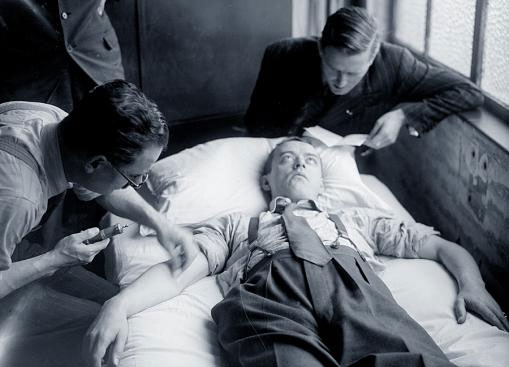Does a true drug exist?
One of the major challenges in life is not knowing whether people are telling the truth or not because humans can almost lie all the time.
There are many tips to identify a liar, such as liars who tend to look away, shake their feet or touch their nose while lying down (also known as the Pinocchio effect). But these are only relative.
So, for years, scientists have been trying to create "truth-telling pills" - drugs that will make criminals open their mouths and declare them all during interrogation. Of these, sodium thiopental (SDT) is considered a bright candidate, but is this drug really effective?
Thiopental sodium
One of the oldest and most famous drugs is SDT - a type of tranquilizer that is widely used in the years 1950-1960 to help people sleep better. Although first created in the 1930s, police and military nations still use it to this day.
Many claims said that SDT was originally used as an anesthetic, which could make people tell the truth. But after that, they are no longer used for this purpose because the drug is highly addictive and even deadly. Movie actress Marilyn Monroe is famous for dying of sedation overdose. Anesthesiologist Austin Leach decided to give a patient a low dose of SDT and monitor the vital signs of this person. Usually, sedatives will slow the rate of sending messages through the brain and spinal cord. The higher the drug is used, the harder it is to pass the distance between nerve cells. The whole process of human thinking will slow down until you fall asleep. With SDT, this happens really quickly.
Although once used as an anesthetic, Dr. Leach found that, when patients are in the midst of consciousness and unconsciousness, they become more alert and not inhibited. After the medicine has stopped working, the patient forgets what they say. This makes the doctors think that SDT can form the basis for the "truthful medicine" - a tool for questioning. But is it really effective?

An experiment of "truth-telling medicine" in England in 1945. (Photo: BBC)
Find the truth
Michael Mosley, a science journalist, decided to experiment on himself. He tried to maintain his vision of Michael Mosley, a famous heart surgeon. At first, he was injected with a very low dose. Immediately, he felt extremely stunned and drunk.
There is a saying, "There is truth in wine . " Alcohol is an anesthetic and inhibits certain nerve centers, areas like the cortex, where thoughts arise. Alcohol reduces restraint but also slows down the thinking process, making it difficult for people to think clearly. In theory, SDT works in the same way. Because lying is often more difficult and complicated to tell the truth, if you block the function of the cortex, you tend to tell the truth, simply because it is easier.
With low doses of SDT, Mosley cannot lie effectively but can still lie."I am a heart surgeon - ha ha ha - heart surgeon, a world-renowned heart surgeon," Mosley yelled when Dr. Leach asked him what he was doing. "Can you tell me the last surgery you performed?" , Dr. Leach asked politely. "It was a heart surgery. They survived, yeah, I was amazing, " Mosley improvised.
But what happens when SDT is increased? Mosley was given an extra injection of SDT and this time, he felt more alert. So what happens next is a complete surprise. Once again Dr. Leech asked Mosley's name and occupation. He did not hesitate to answer immediately."I am a television producer. Yes, operating, producing as well as presenting, combining all 3 jobs." "So, have you never performed any heart surgery?" , Dr. Leech gently asked . "Nothing. Nothing."
The truth is clear.SDT is only capable of distorting short-term memory . There are no reliable "real drugs" . Or suppose there is one, no one will say this.
- How to deal with drug poisoning
- How to provide first aid to people who have drug shock
- Behind the birth of the first anti-HIV drug
- Vietnam has new drugs to help addicts crave for drugs
- See the true shape of the air
- Increasing popularity of new drug-resistant TB strains
- Cedemex: Escape for drug addicts
- New breakthrough in the fight against drug resistance
- Prexige anti-inflammatory drug is withdrawn
- The unexpected reason makes the world scarce of drugs
- Detection of drugs that prevent HIV from reproducing in cells
- Aliens evade Earth?
 Green tea cleans teeth better than mouthwash?
Green tea cleans teeth better than mouthwash? Death kiss: This is why you should not let anyone kiss your baby's lips
Death kiss: This is why you should not let anyone kiss your baby's lips What is salmonellosis?
What is salmonellosis? Caution should be exercised when using aloe vera through eating and drinking
Caution should be exercised when using aloe vera through eating and drinking